- Author
- A.N. Other
- Subjects
- Biographies and personal histories, RAN operations
- Tags
-
- RAN Ships
- None noted.
- Publication
- December 2017 edition of the Naval Historical Review (all rights reserved)
By Hector Donohue
During World War II, RAN personnel operated with their RN counterparts in the dangerous and demanding tasks of BMD in the waters around UK and on shore, and subsequently in the ports of northern Europe. In the Pacific theatre RAN BMD personnel supported Allied operations in the islands to Australia’s north. Post war, Australian navy, army and air force personnel undertook significant bomb and mine disposal operation in New Guinea and the Solomon Islands. Clearance Diving includes BMD skills, and when it was introduced in 1955 there was a rich Australian experience to draw from.
Whilst much has been written about the few RANVR officers who conducted BMD activities in UK and Europe during WWII (and their bravery and well deserved awards, given to 12 officers – including four GCs – and two sailors, is acknowledged), little has been written about the men who conducted BMD in the Australian theatre. In fact, Herman Gill’s official history of the RAN in World War II does not even mention them.
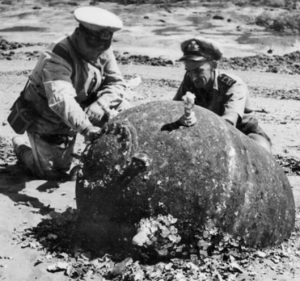
After the Japanese entered the war, the RAN introduced Render Mines Safe (RMS) training at Flinders Naval Depot in early 1942, and RAN personnel were trained by the Army in Bomb Disposal. BMD personnel were progressively deployed to vital ports and eventually in support of operations in the islands to the north of Australia. RMS operations by the RAN in the Pacific theatre were completely different to operations by RANVR officers in Europe dealing with sophisticated German ground mines. BMD in support of Allied offensives focused on unexploded Japanese ordnance and booby traps and those involved lived in the field, often close to fierce fighting.
Although no lists of those qualified in RMS and bomb disposal (BD) during the War have been kept, in excess of 30 RMS officers have been identified from Navy Lists and there would have been at least a similar number of sailors.
Post war, RMS billets were shut down in most areas. Brisbane was allocated staff for RMS along the Queensland coast and Tarangau was built up to cover RMS and BD work in New Guinea. Following the formation of the Electrical and TAS branches in 1948, RMS (and torpedo) training moved from Flinders Naval Depot to HMAS Rushcutter.
Awards for BMD operations by the RAN in the Pacific during WWII and in the immediate post war period were sparse and totalled four officers and two sailors as follows.
Commander(Sp) MS Batterham RANVR
OBE – 5.6.52
Lieutenant(Sp)HL Billman RANVR
MID – 26.6.45
DSC – 6.11.45
Lieutenant CG Croft RANR
MBE – 28.9.43
Lieutenant(Sp) F Nankivell RANVR
MBE – 26.6.45
Able Seaman RF Peel RANR
BEM – 26.6.45
Able Seaman VW Turner RAN
BEM – 1.1.52
A brief summary of the careers of these brave men is given below:
Commander Maurice Samuel Batterham RANVR
Batterham joined the RANVR as a Sub Lieutenant in August 1942. He qualified in bomb disposal at the Amy Base at Bonegilla in October 1942, and as a Diver II at HMAS Penguin in October 1943. He joined HMAS Melville in Darwin in December 1942 for diving and RMS and BD duties and was promoted to Lieutenant in January 1943. He was involved in salvaging materials from sunken ships in the wake of the Japanese bombings and rendering bombs safe as well as a number of Japanese mines washed ashore. In October 1944 he was sent on exchange service with the RN where he commanded two Port Clearance Parties (P Parties 1574 and 1572) in northern Europe following the invasion.
He returned to Australia in January 1946 and was attached to HMAS Tarangau in May as an acting Lieutenant Commander to assist Lieutenant Commander Chas. Croft and a RMS team undertaking bomb and mine disposal activities in the Rabaul area. Batterham devised a gas mask diving system giving the freedom of movement they needed underwater, and the team recovered and disposed of over 150 mines and other ordnance. Batterham returned to Australia in December 1946.
In October 1947 and again in May 1948 he dived on the wreck of HMAS Warrnambool to recover the confidential books from the Commanding Officer’s cabin. As reported by the Senior officer 20th Minesweeping Flotilla: Full credit is due to Lieutenant Commander Batterham RANVR for the successful carrying out of this arduous and hazardous operation which he organised and in which he played an important part underwater, setting a fine example for the rest of the team. He and his seven team members subsequently received Naval Board Commendations. The Admiralty also expressed their appreciation of the recovery of the documents which ensured they remained free from compromise. He was appointed to Navy Office on the staff of the Director of Ordnance and Underwater Weapons in July 1948 and in 1951 was promoted Lieutenant Commander. He initiated the requirement to establish a Clearance Diving Branch in the RAN in 1951 and was the driving force behind the early development of clearance diving in the RAN.
He was awarded the OBE for ‘courage and devotion to duty’in the Queen’s Birthday Honours List in June 1952. His citation noted that: ‘Since 1943 he had been engaged intermittently on mine clearance and other duties of a hazardous nature…including the clearance of former enemy-held ports in Europe and RMS duties in Rabaul after the Japanese surrender. By his skill, courage and leadership he was an outstanding example to his subordinates’. Although the activities mentioned were clearly associated with World War II, the Australian Government, unlike the British Government, decreed that no more awards would be given for the war, and so Batterham did not receive an ‘operational’ award.
After overseeing the first clearance diving course in 1955 he continued to serve in Navy Office as the RAN’s ‘diving expert’. He also oversaw the Mine Countermeasures Development Unit at Rushcutter which developed underwater search techniques. In 1961 he planned and supervised a deep diving operation in support of the Snowy Mountains Hydro Electricity Authority, including arranging for suitable equipment to be procured. A leak had developed in a diversion tunnel at the base of Eucumbene Dam and the only practical method of investigating the problem was by using divers. RAN clearance divers were sent down, ultimately to 285 feet underwater in freezing conditions, and over a period of four months cleared the debris causing the leak, the deepest diving operation on air ever undertaken.
He was promoted to Commander in June 1956 and retired in 1966 to continue his involvement in diving by managing a diving equipment company. He died on 20 August 1996, aged 90.
Lieutenant Harold Leon (Bill) Billman RANVR
Billman joined the RANVR as a Sub Lieutenant in November 1942. He qualified in bomb disposal at the Army Base at Ingleburn in February 1943, before completing a controlled mine course at Flinders Naval Depot in March. He was then posted to HMAS Platypus at Cairns for BMD duties.
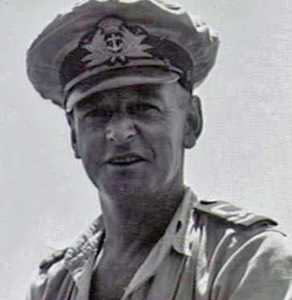
He qualified Diver II at Penguinin May 1943 and in August 1943 he was sent to HMAS Basilisk at Port Moresby where he was engaged in BMD in the New Guinea forward areas. He was promoted Lieutenant in June with seniority of 21 March 1943. In August and September 1943, Billman was involved in the clearance of unexploded ordnance following the Allied landings in Nassau Bay in July. This operation was undertaken so that the Allies could secure a beachhead to establish a supply point to shorten the supply lines for the attack on Salamaua as part of the Salamaua-Lae campaign. For his time at Nassau Bay he was awarded a MID on 26 June 1945 ‘for courage, skill and undaunted devotion to duty in exceptionally hazardous operations’.
He was the first of three RANVR officers attached to the USN Mobile Explosive Investigative Unit No 1 (MEIU 1) in 1944/45. Billman received a Commander Seventh Fleet Commendation in June 1945 that stated: ‘During the period September 1944 to April 1945 you were attached to MEIU 1 and rendered invaluable assistance in clearing unexploded ordnance from the Leyte and Manila Bay areas. By your diligent methods and careful research, you recovered and reconstructed a new type of Japanese mine and a new enemy underwater sound making device. The Commander Seventh Fleet commends you upon your exemplary performance and your contributions to the success of our operations in the Philippines.’
He was subsequently awarded a DSC on 6 November 1945 with the following citation: ‘Lieutenant Billman landed on Panaon Island on 20th October, 1944 with the assault forces. He displayed bravery, devotion to duty and exceptional skill over a period of four months in dealing with Japanese mines and unexploded bombs in the clearance operations in the Philippines’.
He returned to Australia in early May 1945 and served at the Torpedo School at Flinders Naval Depot as a RMS instructor until he was demobilised in December 1945. He died in Wangaratta on 16 April 1968, just 60 years old.
Lieutenant Commander Charles George (Chas.) Croft RANR
Croft joined the RANR as a Midshipman in April 1924, rising to the rank of Lieutenant before retiring in March 1930. He re-joined as a Lieutenant in February 1941 and was posted to Melville in Darwin as RMS and BD officer, and despite undertaking operational RMS activities, did not complete a formal bomb disposal course until October 1942 (probably the same course as Batterham). He was the first Allied officer to render safe a Japanese mine in World War II when he dealt with four Japanese mines washed ashore at Gunn Point, near Darwin, in February 1942. On 28 September 1943 he was awarded the MBE for this operation ‘for great bravery and steadfast devotion to duty’. US Navy mine disposal personnel had no intelligence on Japanese mines and a USN Mine Recovery Unit was sent to Melville in early 1942 to be mentored by Croft.
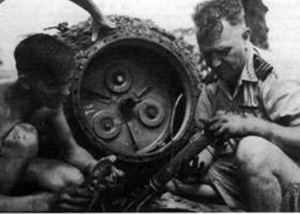
Croft served as the senior RMS instructor at the Torpedo School at HMAS Cerberus in 1944/45 and in late 1945 was sent to inspect the northern battlefields. After ten weeks he reported varying stockpiles of Japanese and US ordnance from Timor to Rabaul. As a result, the decision was taken to put navy and army BMD teams into the islands to commence a clean-up.
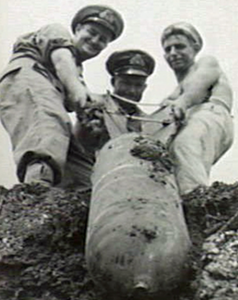
In May 1946 he was promoted to Acting Lieutenant Commander and was attached to Tarangau in New Guinea for BMD duties. He was assisted by Lieutenant Commander Maurice Batterham RANVR and a seven-sailor RMS team. With prisoners of war providing the labour, many hundreds of bombs, mines, depth charges, torpedoes and other ordnance were rendered safe, countermined or dumped at sea. An Army officer officially commending the RAN RMS party noted: ‘The work consisted of delousing and disposing of enemy mines and torpedoes and also anti invasion mines. The work was dangerous and difficult and involved working in many cases under water and in confined tunnels. These officers and men worked with a consistency and despatch which might well have proved too severe for the health of less mentally and physically robust persons’.
He returned to Cerberus in January 1947 and moved the RMS School at Rushcutter in February 1948. He was promoted Lieutenant Commander in June 1949. He had been recommended for an operational MID, but with Australia’s unwavering policy of not considering post war BMD as ‘operational’, the citation lapsed.
At the request of the High Commissioner, Western Pacific, in 1950 the Australian Government agreed to provide a joint Army/Navy BMD unit to dispose of unexploded ordnance in the British Solomon Island Protectorate. The LST HMAS Labuan took a team of five Army and four Navy personnel, led by Lieutenant Commander Chas. Croft, from Sydney to the Solomon Islands, arriving Honiara on 31 July 1950.
Operational control rested with NOIC New Guinea but locally, Croft was in charge. They worked as required in many areas in the islands where unexploded ordnance required disposal. The unit was supported by local native labour supplied by the Resident Commissioner, who also provided land and water transport. The team dealt with tons of unexploded ordnance in difficult conditions both on the job and at their base in Honiara. The three sailors attached to the Unit were rotated after a year, but Croft remained and in mid-1952 fell ill and was returned to Australia. He died on 18 May 1953 in Launceston whilst on sick leave, aged just 47.
Lieutenant (Sp) Francis Nankivell RANVR
Nankivell joined the RANVR in August 1942 as a Sub Lieutenant and completed the 10/42 RMS course at Cerberus. He was posted to HMAS Torrens (Adelaide) as ‘diving RMS and BD officer’. He was promoted Lieutenant in January 1943 and qualified Diver II in March 1943. In early 1944 he was posted to HMAS Ladava (Milne Bay) and for forward areas as required. He worked on the ordnance and booby traps left behind by the retreating Japanese forces. He was awarded the MBE for his work in clearing ordnance in the Cape Hoskins and San Remo areas on the north coast of western New Britain in June-July 1944. He received the award on 26 June 1945: ‘for courage, skill and undaunted devotion to duty in exceptionally hazardous operations. ‘He demobilised early 1945 and died in Melbourne on 20 March 1964, at just 60 years old.
Able Seaman Reginald Frank Peel RANR
Peel was born in Saskatchewan, Canada in 1907. He joined the RN in 1925 and transferred to the RAN in 1928, completing his service in 1937. He joined the RANR in August 1940 for five years’ service. After two years service in the destroyer HMAS Napier, he was posted to Cerberusin September 1942 and qualified in bomb disposal in October. After a brief period in Magnetic (Townsville) he was posted to HMAS Basilisk (Port Moresby) in January 1943. After two years working in BMD in New Guinea, he was given a free discharge in January 1945 ‘on a replacement basis to resume employment with a company in Melbourne’. His extensive time in the field on BMD duties prevented him from qualifying for Leading Seaman. He was awarded the BEM for his work in assisting Nankivell in New Britain and received the award on 26 June 1945 ‘for skill and undaunted devotion to duty in hazardous operations.’
Able Seaman Victor William Turner
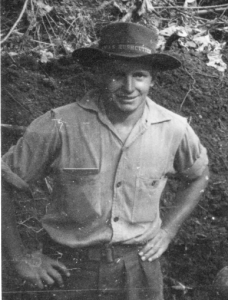
Turner joined the RAN in August 1947 and was posted to Rushcutter in 1949. He qualified in RMS in January 1950 and was one of the navy team who went to Honiara in July 1950. He was awarded the BEM on 1 January 1952 for his bravery following the rescue of a Solomon Islands native from a burning stack of exploding 20 mm ammunition on Honiara Island in 1951. The citation stated: ‘He showed complete disregard for his personal safety in assisting the wounded native to safety and in returning to the danger area to another native whom he had seen. Turner knew well that a major explosion could have been expected at any moment and, in fact, numerous explosions did occur.’ As he was at sea in HMAS Condamine off Korea at the time the award was presented, his sister collected it from the Governor of Queensland in February 1953. He left the Navy in 1959 as a Petty Officer.




